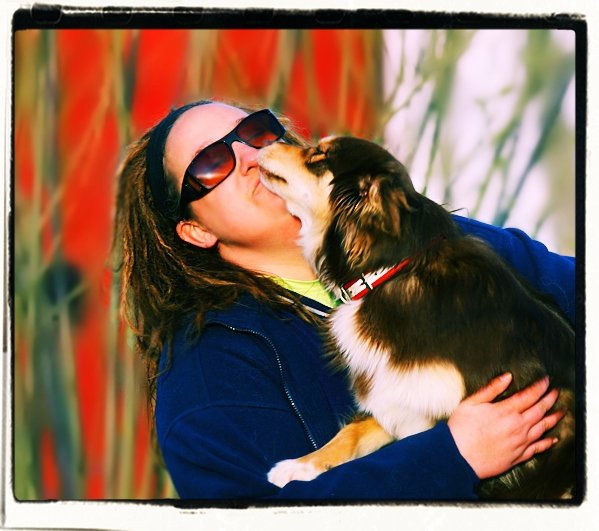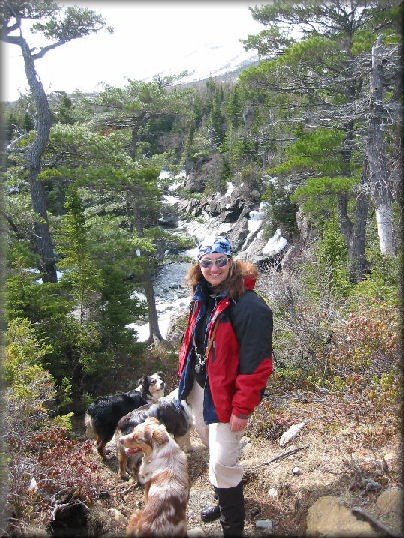… with Lisa Giroux from Fort Erie, Ontario (she used to live in rural Newfoundland)

(All photos Jen Harding)
Lisa Giroux is a dog trainer originally from Arkansas. She has competed in agility, flyball, disc, obedience, stockdog trials, and conformation shows.
She was Training Director and founding member of K9 Search and Rescue, Newfoundland and Labrador with a certified K9 partner from 2004-2011.
She was also Training Director for Bay of Islands Search and Rescue for several years in Western Newfoundland.
She has been on the Education Committee for the Australian Shepherd Club of America and was a representative for their national Rescue Association.
She has worked for a national Guide Dog school for several years.
Today, she lives in Fort Erie, Ontario with her family and her two Australian Shepherds (Presto and Dally), two parrots (Chet and Rocky), and one very spoiled calico cat (Jade).
Lisa, why do you say you are a dog trainer but you mostly teach humans?
I teach people how to communicate with pets and how to teach pets. There is a huge movement to go to obedience classes with dogs. It is nice if dogs know how to react to obedience commands.
But it is far from all what is needed. I focus more on how to integrate the dog into family life. I teach people how to raise their puppy and how to make their dog into a good pet at home.
How did you find your way to educate people and dogs?
I did agility, flyball and obedience competitively and that’s where I started teaching, but I became really serious after I became a Puppywalking Supervisor for a guide dog school. These schools usually raise their own dogs which go to foster homes before they become guide dogs. I supervised the way people in the foster homes raised and trainedthe puppies.

What did the Puppywalking Supervisor job show you?
I learned from that job that there are many different ways that people learn and many different family dynamics. I had to be able to adjust to each type of person and be able to quickly evaluate each situation in order to teach the people.
The dog part is a fairly exact science — it’s the people that present the most challenging piece of doing a good job as a dog trainer!
What do some people do wrong in regards to dogs?
In the foster homes for guide dogs, people were very motivated because they were volunteers that were screened and knew what to expect from their job. But whenever people call me who have problems with dogs, the lack of motivation is a huge issue.
Whenever people called me, I must to find out what bothers the people most so that I can reduce their stress immediately. In this way, I help the dog right away, because a person that is less stressed will be more likely to want to work with their dog. So if I want to help the dog, I must look first to making the person’s life easier, and motivating the person to want to do the work necessary to make the dog easier to be around and manage.
Why do people get tired of dogs?
I will give you an example: People have a dog that barks all the time and it is driving them crazy. They are angry and tired and they are not sure anymore whether they still like their dog.
When they call a dog trainer like me, it is usually their last hope, the last thing that they are trying.

What first-aid do you offer to them?
The first thing is to help the people. I give them a short-term solution to reduce their stress and frustration so that they are happy again to work with their dog.
It can be a small thing, like removing a chair from the window, if it is a small dog that barks at people who are passing in front of the window.
This stops the immediate problem so that we can start fixing the long-term problem which is likely lack of mental stimulation and lack of general training and control. The quick fix of moving the chair helps relax the people by removing some of their frustration with the problem.
The key is to motivate the people!
Before you moved to Fort Erie in October 2011, you had lived for three years in Pasadena and six years in the Codroy Valley. What were the challenges that you encountered there?
When I went into the more rural areas of Newfoundland, I often found that people allowed their dogs to roam unsupervised. In many cases, the general attitude was that no training was necessary, and the concept of socialization was poorly understood, if at all.
If there were problems with the dog, the general attitude was often that the dog was somehow “bad” and the dog would be given away or “gotten rid of.” The concept of working with the dog to change its behaviour was pretty foreign. This is something that education is gradually fixing and certainly is not limited just to Newfoundland.
How can anybody just get rid of a pet?
This happens in other rural areas too, for instance in rural Arkansas, where I come from.
Many people see dogs and pets in general as disposable which I find bothersome. People dump even pets for which they have paid a lot of money.
I have done rescue for many years for all different breeds, and I have seen dogs in rescue that were bought for thousands of dollars — not just mixed breeds or strays.
How are the problems with the dogs created in the first place?
Often, people get their dogs as puppies and intended for them to be house dogs. But because the owners did not have enough knowledge, the dogs were not raised properly and were not trained. As they grew up they became unruly. Usually this starts to happen at around 7-10 months of age.
So people tie them on outside for longer and longer periods of time. Eventually, the dog ends up living outdoors on a chain all or nearly all of the time. Unfortunately, this is very common.
It is not on a lot of people`s radar to conscientiously train or socialise their dogs. People just get a puppy and expect things to fall into place on their own. This almost always ends badly for the dog.

How do you explain to people that dogs have to be socialised?
I ask them how their child would turn out if it was kept in a room until it is 10 years old and then set loose in society and expected to act normally. In fact, I have an article on this very subject on my website that talks in-depth about this very subject.
But some people would tell you: Dogs are not children. What do you tell them?
They are absolutely right. But if you want a dog to be able to behave friendly and calm in different environments, the dog has to be socialised and exposed to different environments. You take the dog with you to different places and make him part of your daily activities.
Otherwise a dog becomes fearful and fearful dogs bite.
If you want a dog that is calm and happy and trustworthy and not a risk to other people, you have to prepare your dog for this kind of life.
The average dog is brought home and sees the inside of one home, its own backyard, and if it is lucky, gets walked around the block a few times a week. This is not nearly enough exposure to the world to prepare a dog for handling all the experiences it might encounter throughout its life.
Can you tell us what is important to have a happy, trustworthy dog?
The main thing is that very young dogs have to learn how to be with humans and follow them.
A good way to teach this is to have a puppy on a leash inside the house for part of the day and follow you.
This way, a puppy learns to follow a person`s directions and it does not learn to chew on things.
It looks to the owner for directions.
Note: Practice makes perfect. Whatever the dog practices, it gets good at. Don`t let it practice chewing on things or peeing on the carpet.
What should people do with puppies?
When puppies come into the house, they have to come when they are called from day one.
What happens is that puppies naturally stick to people’s feet when they are young, and naturally respond when called with great enthusiasm when they are little.
So, owners feel quite secure that the puppy is responsive and doing well with its recall (coming when called). But when they get older, at the age for 3 or 4 months, that natural tendency stops. They want to explore and are much more independent, and if the owner has not put in some effort of real training by that time, the puppy is going to quickly learn that NOT coming when called is much more fun that coming back.
So start that recall training the moment that puppy arrives home! Keep treats in your pockets at all times and call that puppy to you and reward him every time you think of it.
This seems such a simple thing.
Yes, it is simple but so important. I don`t know one single person who is happy with a dog that does not come when you call it.
What else bothered you while you lived in rural Newfoundland?
People who keep a dog on a chain. This is in my mind the ultimate form of cruelty. I really question why these people have a dog at all.
Is there hope for a better future for dogs in Newfoundland?
Yes. I saw improvement in the 9 years I lived there. There is progress.
Education is happening.
But legislation for the protection of animals is only good if it is enforced.
People should write to their government and tell them what they want and what they don`t want.
Lisa, thank you very much for this interview!
Thank you for having me! I have a web-site that I have written for people who would like to have some basic training tips.
I took all the most common questions that I get, and wrote articles to answer those questions. Go to www.k9station.com and click on “Training Tips.”
If you don’t find an answer there, you can write to me and ask me personally. I am glad to try to help if I can.
Read here: Lisa`s Training Tips. Click here.
There are two books that I enjoy recommending to people that really opened my eyes about dog training in general and about how dogs think and learn. These books are intended to teach you how to be a dog trainer, and how to troubleshoot on your own with your dog.
The first is The Culture Clash by Jean Donaldson.
The second is Don’t Shoot the Dog by Karen Pryor.
Neither book is a traditional “how to teach your dog to sit” book — these are true theory books that will truly teach you how to go forward in nearly any situation to fix problems and really understand your dog.

